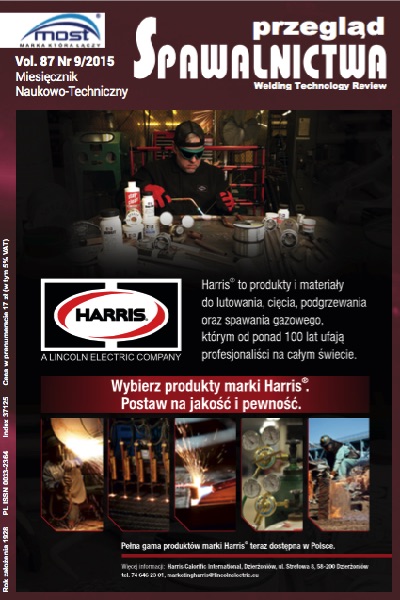Study significance of the impact of the basic parameters of plasma surfacing on the geometry of the weld overlays
Main Article Content
Abstract
The influence of the main parameters of plasma powder transferred arc welding on the geometry of the weld overlays is presented in the paper based on the Design of Experiment methods. The matrix experiments was planned according to the Plackett-Burman plan whereas research data handling was based on random balance method. As a result, plasma welding parameters which significantly influence the geometry of the coating and its dilution was determined. It has been shown that particular surfacing parameters have different impact onto measured values.
(in polish)
W oparciu o metody planowania eksperymentu przedstawiono wpływ głównych parametrów napawania plazmowego proszkowego na geometrię napoin. Ekspe- ryment wykonano na podstawie matrycy planu Placketta-Burmana a matematyczne opracowanie wyników badań w oparciu o metodę bilansu losowego. W efekcie wyznaczono parametry napawania plazmowego, które istotnie wpływają na geometrię powłok i udział metalu podłoża w napoinie. Wykazano, iż występuje zróżnicowanie wpływu parametrów procesu napawania na mierzone wielkości.
Downloads
Article Details
Creative Commons CC BY 4.0 https://creativecommons.org/licenses/by/4.0/
Welding Technology Review (WTR) articles are published open access under a CC BY licence (Creative Commons Attribution 4.0 International licence). The CC BY licence is the most open licence available and considered the industry 'gold standard' for open access; it is also preferred by many funders. This licence allows readers to copy and redistribute the material in any medium or format, and to alter, transform, or build upon the material, including for commercial use, providing the original author is credited.
References
Deuis R.L., Yellup J.M., Subramanian C.: Metal-matrix composite coatings by PTA surfacing. Composite Science & Technology, 58, 1998, 299-309.
Liu Y. F., Xia Z. Y., Han J. M., Zhang G. L., Yang S. Z.: Microstructure and wear behavior of (Cr,Fe)7C3 reinforced composite coating pro- duced by plasma transferred arc weld-surfacing process, Surface & Coatings Technology, 2006, No 201, 863 867.
Liyanage T., Fisher G., Gerlich A.P.: Microstructures and abrasive wear performance of PTAW deposited NiWC overlays using different Ni-alloy chemistries, Wear, 2012, No 274-245, 345-354.
Jitai N., Wei G., Mianhuan G., Shixiong L.: Plasma application in thermal processing of materials, Vacuum 65, 2002, 263 266.
Weroński A., Gardyński J.: Nakładanie powłok metodą plazmową na części samochodowe, Przegląd Spawalnictwa nr 1 2, 1996, 14 16.
Weroński A., Pałka K.: Zwiększenie trwałości nurników homogenizatorów przez napawanie plazmowe, Przegląd Spawalnictwa nr 1 2, 1996, 20 22.
Klimpel A., Górka J., Czupryński A.: Napawanie proszkowe PTA warstw wierzchnich suwaka zasuwy urządzeń naftowych, Przegląd Spawalnictwa nr 5 6, 2006, 15 19.
Górak J., Czupryński A., Kik T., Melcer M.: Przemysłowe aplikacje
napawania plazmowego proszkowego, Przegląd Spawalnictwa nr 9,
, 87-94.
Polański Z.: Planowanie doświadczeń w technice, PWN, Warszawa 1984.
Korzyński M.: Metodyka eksperymentu, WNT, Warszawa 2006.
Kukiełka L.: Podstawy badań inżynierskich, PWN, Warszawa 2002.
Zając A., Kubiszyn I.: Analiza procesu napawania drutem proszkowym samoosłonowym Lincore 50 przy zastosowaniu metody planowania eksperymentu, Biuletyn Instytutu Spawalnictwa No 4, 1993, 35-39.
Fydrych D., Rogalski G.: Wpływ warunków spawania podwodnego metodą lokalnej komory suchej na zawartość wodoru dyfundującego w stopiwie, Przegląd Spawalnictwa No 11, 2009, 29-34.
Fydrych D., Sommer S., Rogaski G.: Wspomaganie decyzji zakupu urządzeń do spawania metodą MIG/MAG z wykorzystaniem analizy skupień,Przegląd Spawalnictwa No 12, 2014, 26-33.
Bęczkowski R., Gucwa M.: Statystyczna ocena wpływu parametrów napawania SSA na geometrię napoin, Przegląd Spawalnictwa No 10, 2011, 40-43.
Balasubramanian V., Varahamoorthy R., Ramachandran C.S., Babu S.: Abrasive slurry wear behavior of stainless steel surface produced by plasma transferred arc hardfacing process, Surface & Coatings Technology, 202, 2008, 39033912.
Ramachandran C.S., Balasubramanian V., Varahamoorthy R.: Comparative evaluation of dry sliding wear behaviour of plasma transferred arc hardfaced surfaces by the pin-on-roller method, Proc. IMechE Vol. 224 Part J: J. Engineering Tribology, 2010, 91-106.
Siva K., Murugan N., Raghupathy V.P.: Modelling, analysis and optimisation of weld bead parameters of nickel based overlay deposited by plasma transferred arc surfacing, Archives of Computational Materials Science and Surface Engineering, vol. 1, 2009, 174-182.
Siva K., Murugan N., Logesh R.: Optimization of weld bead geometry in plasma transferred arc hardfaced austenitic stainless steel plates using genetic algorithm, Int J Adv Manuf Technol, vol. 41, 2009, 2430.
Lakshminarayanan A. K., Balasubramanian V., Varahamoorthy R., Babu S.: Predicting the Dilution of Plasma Transferred Arc Hardfacing of Stellite on Carbon Steel Using Response Surface Methodology, METALS AND MA- TERIALS International, Vol. 14, No. 6, 2008, 779-789.
Tobota K.: Wpływ podstawowych parametrów napwania plazmowego na geometrię napoin, Praca Dypl. Inż., Zakład Inżynierii Spajania PW, Warszawa 2014.
Klimpel A.: Technologie napawania i natryskiwania cieplnego, wyd. Pol. Śląska, Gliwice 1999.
Bober M., Senkara J.: Wpływ podstawowych parametrów napawania plazmowego na udział metalu podłoża w napoinie kompozytowej; Sympozjum Katedr i Zakładów Spawalnictwa, Gliwice, 10.X.2003r, Materiały konferencyjne, 51 60.
Bober M., Senkara J.: Formowanie się napoin na bazie niklu z węglikami metali przejściowych, Biuletyn Instytutu Spawalnictwa, nr 5/2010, rocznik 54, 103 107.
